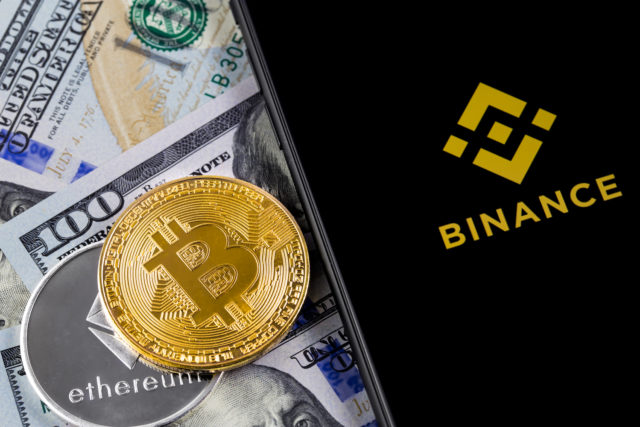Early in the morning of October 24, the Bitcoin rate rose sharply to 35 thousand, reaching a level last recorded in May 2022. A few hours before the rise began, it became known that two large companies – BlackRock and Grayscale – were close to approving applications for their own exchange-traded funds (ETFs) for Bitcoin. The launch of such ETFs is considered in the crypto community to be a catalyst for a new bull cycle in the market, writes RBC Crypto.
The price action comes after BlackRock’s Bitcoin ETF, iShares Bitcoin Trust, appeared on a list maintained by the Depository Trust and Clearing Corporation (DTCC). “This is the first spot ETF to be included in the DTCC list, there are no others yet,” wrote Eric Balchunas, a senior ETF market analyst at Bloomberg. “It is noteworthy that BlackRock is leading in the preparation stages, which usually occur immediately before the launch. It’s hard not to take this as a signal that approval [их биткоин-ETF] inevitably”.
Various exchange traded funds (ETFs), including gold, have trillions of dollars in assets under management. It is generally accepted in the crypto community that even a small percentage of this capital can in the future affect the global crypto market. Several management companies are now awaiting approval of their own Bitcoin ETFs by the US Securities and Exchange Commission (SEC).
If their ETF is approved, the demand for cryptocurrency will increase: when buying shares of funds, it is implied the supply of Bitcoin as an underlying asset, that is, its direct purchase on the market, affecting the rate. BlackRock alone has assets under management totaling about $9 trillion. According to the analytical company Chainalysis, North America is the largest cryptocurrency market, with an annual turnover of approximately $1.2 trillion. This amount exceeds 24% of the global annual cryptocurrency transaction volume.
Growth factors
Shortly before the rise, it also became known that the court issued a ruling obliging the SEC to reconsider Grayscale’s application to convert its Grayscale Bitcoin Trust (GBTC) into a full-fledged spot Bitcoin ETF. Grayscale has been seeking this since 2021, when it first sued the regulator, challenging its past refusals to review its application. The assets in her trust exceed $19 billion.
The growth in recent days is a consequence of a set of factors, explains cryptocurrency market analyst Viktor Pershikov. On the one hand, a significant buy position was formed in the range of $26–28 thousand, which is clearly visible from the growth of open interest in recent weeks.
“Obviously, most of the demand was generated based on expectations of approval of spot Bitcoin ETFs,” explains Pershikov, speaking about the factors that influenced the growth of the cryptocurrency.
“Geopolitics also played a role: rising gold prices amid problems in certain regions quite often led to rising Bitcoin prices in the past.”
According to Andrey Podolyan, CEO of the Cryptorg trading platform, it cannot be completely ruled out that the payoff was made by insiders of the ETF market, who benefit from fueling demand from retail traders. In addition, geopolitical instability has brought its fruits: along with gold, investors prefer to choose Bitcoin, Podolyan agrees with the previous expert.
What will happen next
Another important factor that added impetus to the growth of the Bitcoin rate was the exit from the narrow trading range that had been forming since the summer, adds Pershikov. This led to the liquidation of a significant volume of short positions, the expert explains.
During the day, a sharp increase in the rate of Bitcoin and other cryptocurrencies provoked a massive forced closure of margin positions of traders who were unable to add collateral to their orders. More than 70% of them were “short”, that is, they bet on the market falling. According to the Coinglass service, which tracks the wallets of large crypto exchanges, from October 23 to October 24, positions totaling $400 million were forcibly liquidated.
A game to reduce the price (short position, shorts) involves the sale of an asset that the trader does not own and borrows it from the exchange. The trader opens a short position, hoping to buy back the asset after the price falls and thereby make money from the decrease in value. A significant increase in the price of an asset often provokes a situation called “short squeeze”: a sharp increase forces traders to close short positions and buy back the asset in order to return it to the exchange. This, in turn, provokes an even greater rise in prices.
“Judging by the current momentum towards $35 thousand, the price movement is in an active phase, and it is unlikely that positions will begin to be fixed in the market in the near future,” says Pershikov. The realization of the main factor (ETF approval) is still a long way off, and market participants will continue to form a long position in anticipation of this event.
“In this regard, I continue to expect to reach the $40 thousand level by the end of the year.”
“From a technical analysis point of view, there was a void after the $31.5K level, and we quickly covered this distance after the breakout due to traders taking short positions (in particular, those who traded a potential Head and Shoulders” in the daily range),” analyzes Podolyan.
Head and Shoulders is one of the most famous technical analysis patterns, indicating a trend reversal. It appears on the chart when, after an uptrend, a new price peak is drawn, but already below the maximum price. The maximum price peak is seen as the “head”, and the lower peaks surrounding it are seen as the “shoulders”. The price crossing the so-called neck line often means a trend change.
According to Podolyan, most likely, large players will continue to provoke the liquidation of short positions even among those traders who trade with low leverage. The expert calls the next goal to fix the price at $36 thousand and further increase to $38 thousand.
Source: Cryptocurrency
I am an experienced journalist and writer with a career in the news industry. My focus is on covering Top News stories for World Stock Market, where I provide comprehensive analysis and commentary on markets around the world. I have expertise in writing both long-form articles and shorter pieces that deliver timely, relevant updates to readers.







